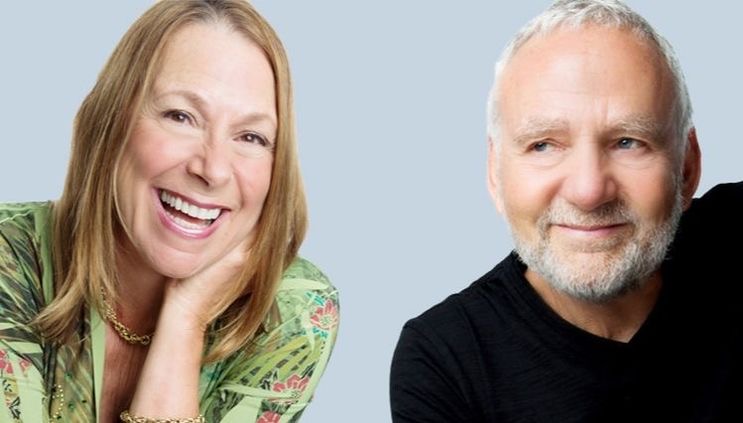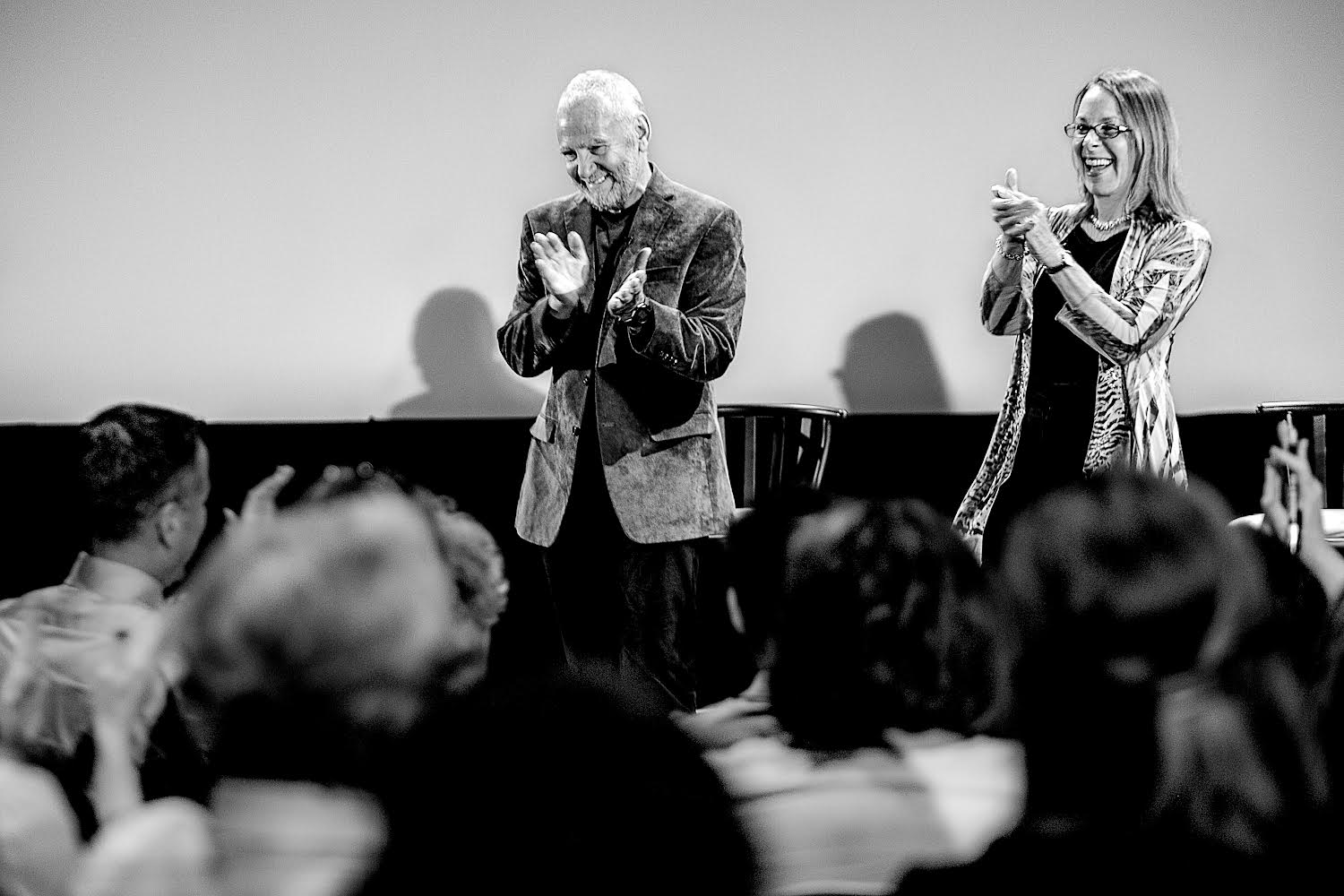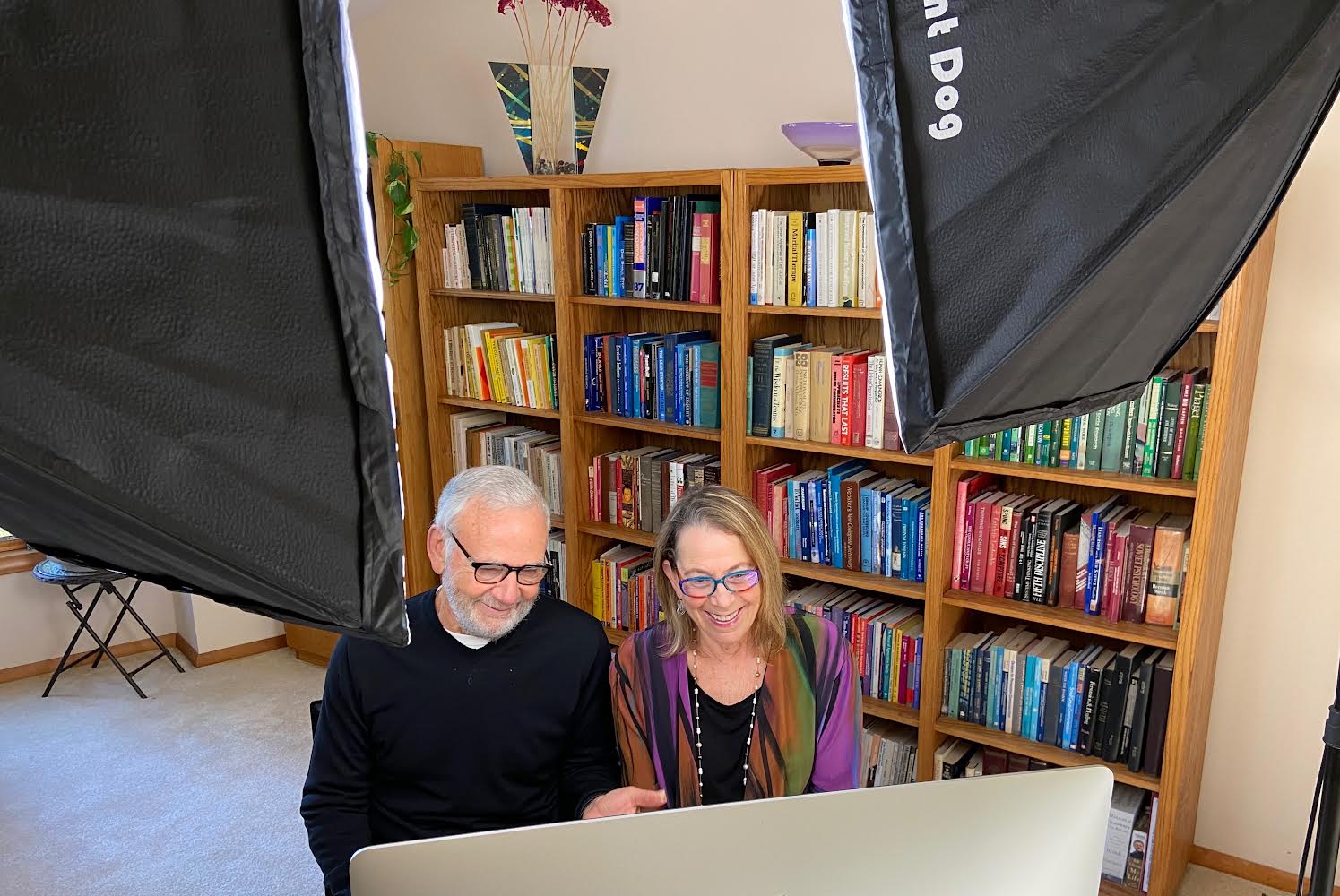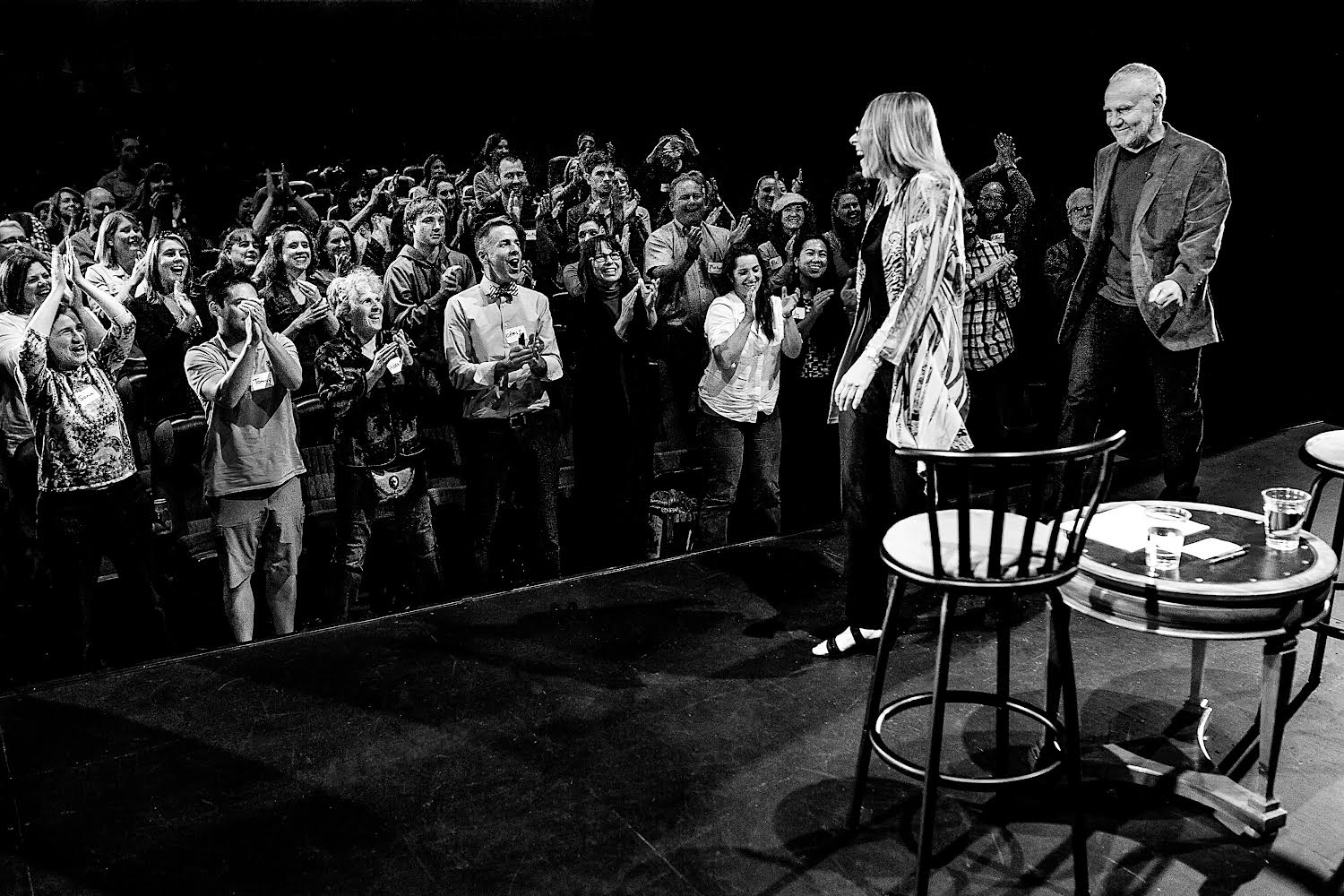Peter Glaser is a very cool guy; easygoing, easy to talk to, and animated on stage. One would never guess that he came from one of the toughest, most brutal neighborhoods in NYC. In a life-gives-you-lemons story, he and his wife and constant companion Susan have become the go-to source for interpersonal communication and, especially, conflict communication. Their special sauce is they are both highly proficient trained actors who combine that skill with decades of research and data.
Seeing them give a series of unforgettable presentations at Rancho La Puerta last month, I was struck by how unique they are. Conflict, disagreement, and misunderstanding always involves 2 sides, be they individuals or groups. It is one thing to read a book or watch a TED-type talk on it, but it is vastly more powerful to watch a couple of skilled actors perform it, and then see what a solution could be. They have now taken their work a step further, with their award-winning e-learning program.
What most impressed me was the genius they had to foresee this life path. They understood they had unique skills as actors, and if they combined it with deep, rigorous research, they could bring knowledge to people in a way that carried tremendous impact. In other words, they took what would otherwise be thought of as not-so-compatible skill sets and made something magical from them. It is clearly working for them and their clients, as neither have any intention of stopping; they are just having too much fun.
Since it is our tradition at AGEIST to do a single-person profile, we will bring you the equally fascinating Susan Glaser later this winter.

Peter, tell me why you guys have been involved in communication for decades. What is it that interests you about communication?
Well, we’ve been into communication for the better part of 50 years, and what interested us is people. We were always interested in people and how you can connect at a very significant level. And that involves communication as a focus, as a mission. I’m trying to keep it on me, but it’s hard not to include Susan here. When I married her, my proposal was that we’d be on a stage together because we both have theater backgrounds. And we can use our theater to promote communication and to demonstrate communication. It’s always been a primary mission in our life to create good, direct, honest communication between people.
“It’s always been a primary mission in our life to create good, direct, honest communication between people”
So, you guys do something, which I think is uniquely powerful, that you combine science with acting it out. How did you come up with this?
Well, kind of you to say that. But what we figured out was that it’s one thing to do the research and the science part, and that was very important to us. But it’s another thing to get it across to an audience and let them really understand it and see it in action. And so it seemed to us that rather than leaving our acting behind, we could bring it forward and show people how this is what it normally looks like when people are in a contentious situation.
People remember us for sometimes outrageous demonstrations. Growing up in Brooklyn, New York, sometimes I work [laughs] that into it. But we want to show them in a very dramatic way. When things are going bad, they can go really bad. And yet, even taking a bad sample like this, here’s how it can be so effective.
Peter, why do you think acting out these is so much more powerful than just somebody going up there and spouting out data or suggestions?
Well, it’s that cliché: seeing is believing. We’ve been to enough speaking engagements, watching other speakers in action, and knowing that there is a vast difference between hearing about things and seeing things in action. And it’s always been our feeling that dramatic presentations move people, and much more than simply data and words. Our hope is to combine them both; they get the legitimacy of the data on the one hand, and then they get the drama of the presentation on the other and put those two together and you’ve got something powerful that sticks in the long-term memory.

Growing Up in Coney Island
Where are you from?
I grew up in the Coney Island section of Brooklyn, NY. I attended Mark Twain junior high school, where the demographic was almost entirely Italian, black, Puerto Rican, and a smattering of Jews. I was one of those. The Italians were my greatest challenge. I was on the bus on the first day of school, and a gang of Italians kept pulling the cord. I said, “Stop pulling the cord. You’re going to make us all late…” They looked at each other in disbelief. Amazed that anyone (especially a small-sized Jewish-looking guy like me) would have the balls to confront them. The biggest of the group walked over, and I stood up, and we stood toe to toe facing each other. He then punched me in the face and the others gathered round and kicked me while I was down.
That was just the beginning. When I returned home on the bus, they were waiting for me. They got off at my stop, dragged me into an alley, and with two holding each of my arms one of them punched away. When I returned home and told my parents the sad story, their response caught me off guard. My tough, stocky, truck driver father said, “You’ve got legs, don’t you? Why didn’t you kick?” The message was clear. If you’re going to live in this neighborhood, you’d better fight.
When I went to Abraham Lincoln high school, the fighting abated, but I never did get into the rhythm of study or extracurricular activities. The one exception, I did make the swimming team and spent most of my spare time in the pool rather than studying. And it did allow me to become a lifeguard on the beaches of Coney Island, where I worked my way up to Chief Lifeguard on the rough and tumble section behind the amusement park. Drownings, murders, and even gang wars were not uncommon events. I thoroughly enjoyed the work.
“It’s our feeling that in conflict and disagreement are the seeds of some higher truth”
So you clearly know a lot about conflict, especially the physical form of it. Now your work is about a less gladiatorial form of conflict. What is it that you like about conflict?
It’s our feeling that in conflict and disagreement are the seeds of some higher truth; that people inherently disagree with one another when they want to get something done. And figuring out the source of the disagreement and being able to unfold it in a very systematic way allows a higher truth. There are three things: the problem is solved, the relationship is strengthened, and trust is deepened. And that’s what we see as the bottom line for any conflict situation. And it works for individuals, and it even works in groups. And when it’s disagreement in groups, what we’ve discovered is: once you can look at that disagreement, the group itself can use that to make a stronger agreement. So, we’re big on conflict. And as a married couple for 51 years, we’ve had plenty of practice [laughs], and we’ve worked it through, and we do use our tools very much.

4-Step Model for Difficult Conversations
Say you have an issue that needs to be brought up, and it’s sort of bothering you. How do you bring it up with the other person? What are your techniques?
Well, first to get their buy-in to even have the conversation in the first place. To be able to say something along the lines of, “Frank, there’s something that I’d really like to talk to you about; is this a good time?” Then to convert accusative terminology, into an “I feeling statement”: “I’m really worried and concerned about how our work project is going.”
Second, is to pinpoint the details of the issue: “Yesterday you told me you would not be able to complete the project on time and the customer would just have to wait.”
The third move is an unexpected powerhouse. To share your own contribution to the problem. Every problem has two people contributing to a problem and discovering your contribution and communicating it to the other person is extremely disarming: “I saw you struggling early on and should have mentioned this earlier.”
The fourth and final step is to develop a two-part solution where both individuals participate. Unilateral solutions often fail. So, in this case, I might say, “Here’s what I can do.” Since I brought up the issue, I should be willing to go first. And then I say, “Is there anything else you want from me?” And then finally, “Here’s what I’m asking of you.” This is a four-step model that allows you to ask for behavior change without evoking defensiveness. We sometimes refer to this approach as “kind candor.”
I know you guys work a lot with big companies and brands. But this sounds like something that’s very applicable in day-to-day marriage relationships, friends, all of this.
Absolutely. Early in our career, we were marital therapists, very early on. And what we discovered was Susan would take the part of the woman, I would take the part of the man. And we’re getting into arguments ourselves because it seems so reasonable from the gender’s point of view. So, we got out of that. And now the only time we get close to family is when we’re working with a big family on business. But for the most part, we are corporate and we deal with big organizations.

E-Learning
Talk to me about the online learning that you have.
Well, our online learning recently won gold, for the best hybrid learning of 2022 from IELA the International E-Learning Association. When Covid hit, we had a big series of conferences lined up and almost all of them said: If you can do this virtually, we’re good to go. We were at a turning point. We decided to pour ourselves into developing an online presence. We always wanted to do it but we were on the road so much we never had the time. Ironically, Covid provided us with this opportunity.
Congratulations. What sort of person would the e-learning course be aimed at?
The same organizations that were hiring us for in-person work moved to the online version. And the big advantage to them, of course, is they don’t have to send all their people to a conference and it was much easier for them to schedule. And of course it was a lot less expensive. So, our e-learning was better for our client organizations and individuals taking our courses.
“We’d like to be the pipeline for people to become master communicators”
What’s your ambition for the next five years?
Well, we’d like to be the pipeline for people to become master communicators. We’re in the process of training trainers to do what we do, and we have a number of our trainers working in various organizations. We want to continue refining this product that we’ve got going. It feels like every time we speak to an audience, we discover something new. And we want to keep making it better and better. It’s strange, but it feels like we’re these youngsters with this wonderful business that’s growing. People say, “What is your hobby?” Our hobby is this business. We’re into hiking, but that’s more exercise. Our real passion is creating a product that really becomes something that is embraced by everyone.
We work with Congress; that’s been the struggle of our life, getting them to embody our work, although we have had some breakthroughs with them as well. So, we’re trying to create a situation where people are creating a habit around communication mastery so that they can really move into any challenging situation and come out the other end, as I said earlier, with the problem solved, the relationships strengthened, and trust deepened.
“Retirement is not something that we have ever sought as a goal”
What’s your feeling on retirement in general?
It works for some people. I have also seen people retire three and four times because it doesn’t take. And then finally, it takes, and they’re happy. And so, at least for Susan and myself, retirement is not something that we have ever sought as a goal. And as we move into later years, it’s something that we push back further and further. And I think we’ll probably be wheeled onto a stage [laughs] in this context. It is just so much fun. And isn’t life just enjoying things? And that’s where it is right now. So, personally, no retirement. For other people, maybe it works.
What are the three non-negotiables in your life?
Interesting you should ask. One non-negotiable is: I will not retire. I am having such a good time. And it is so energizing to be in front of audiences; whether online or in-person, it is such a kick. So, that is going to happen until I can’t do it anymore. But I’m pretty darn healthy. I plan on another 10 or 15 years anyway. Another non-negotiable: I am addicted to health and physical fitness. I am a maniac on the trails, in the gym; I just like it. And when I don’t get to do it — and sometimes things can get bad enough here environmentally when we have forest fires — I’m doing jumping jacks, I’m running in place, doing anything to keep going. So, that’s another non-negotiable. And the third, and it’s related to the other two, is a continuous commitment to growth, to intellectual growth, to finding new ways of doing things, especially in our field of communication, so that we keep getting better and better at what we do.
Seen a lot of people go down very quickly when they retire. But that isn’t why we’re not retiring. It’s not because we’re afraid that we’ll fall apart. It’s more positive; things are great right now. We will want it to keep going.
LEAVE A REPLY
The ideas expressed here are solely the opinions of the author and are not researched or verified by AGEIST LLC, or anyone associated with AGEIST LLC. This material should not be construed as medical advice or recommendation, it is for informational use only. We encourage all readers to discuss with your qualified practitioners the relevance of the application of any of these ideas to your life. The recommendations contained herein are not intended to diagnose, treat, cure or prevent any disease. You should always consult your physician or other qualified health provider before starting any new treatment or stopping any treatment that has been prescribed for you by your physician or other qualified health provider. Please call your doctor or 911 immediately if you think you may have a medical or psychiatric emergency.



Wow, I loved this article. I’m currently setting up a mediation and dispute resolution business, and this has really inspired me to think bigger – beyond the dispute I’ve been called in to help resolve but to think about what good communication really means to people, and why we need it so much! Thank you
I like the *ideal* of this 4-step process and can see how it fits workplace conflicts to a tee. I tend to think that between two people, it won’t get past the gridlock of entrenched, family scripts and perhaps diagnosable personality traits.